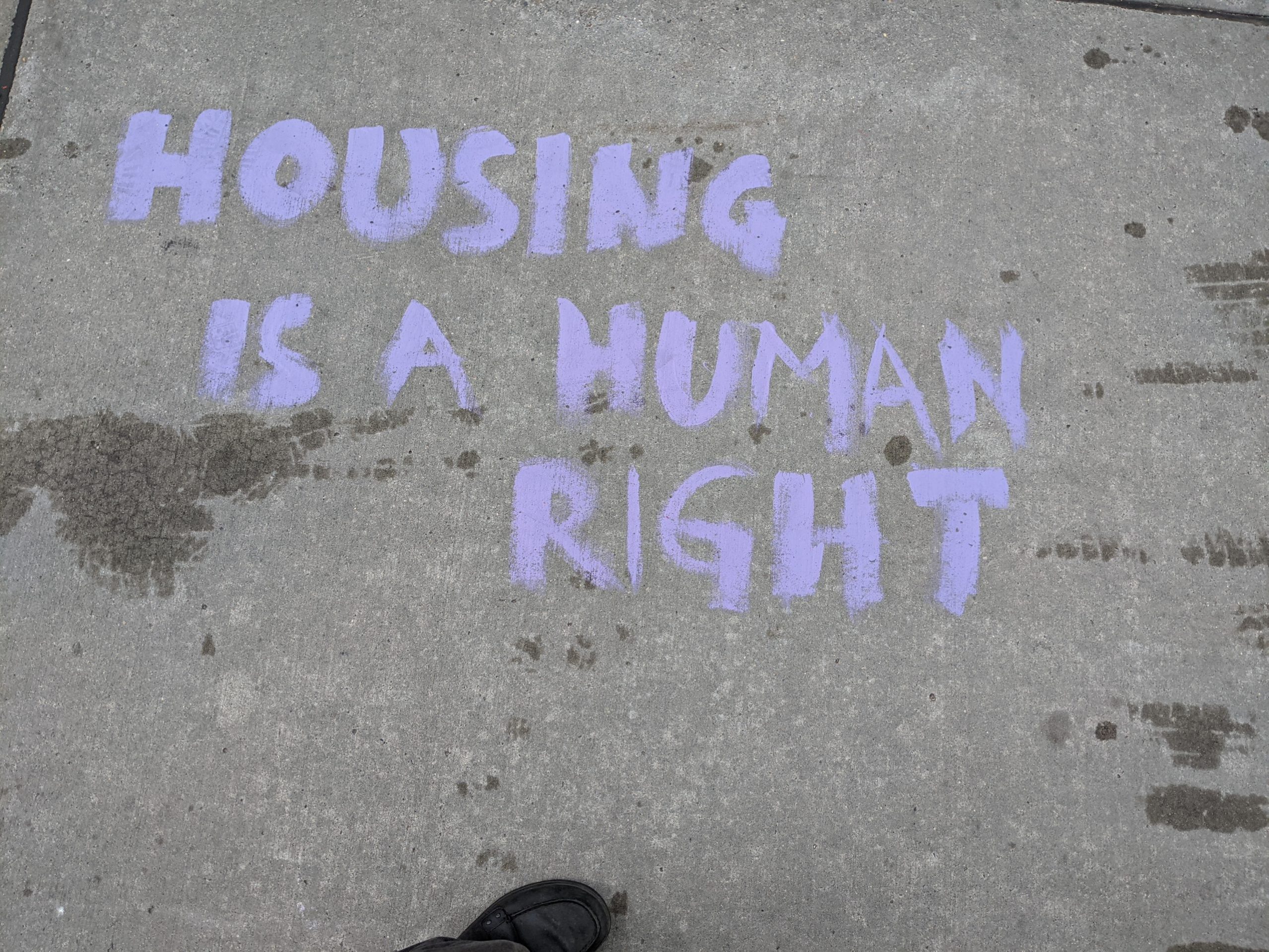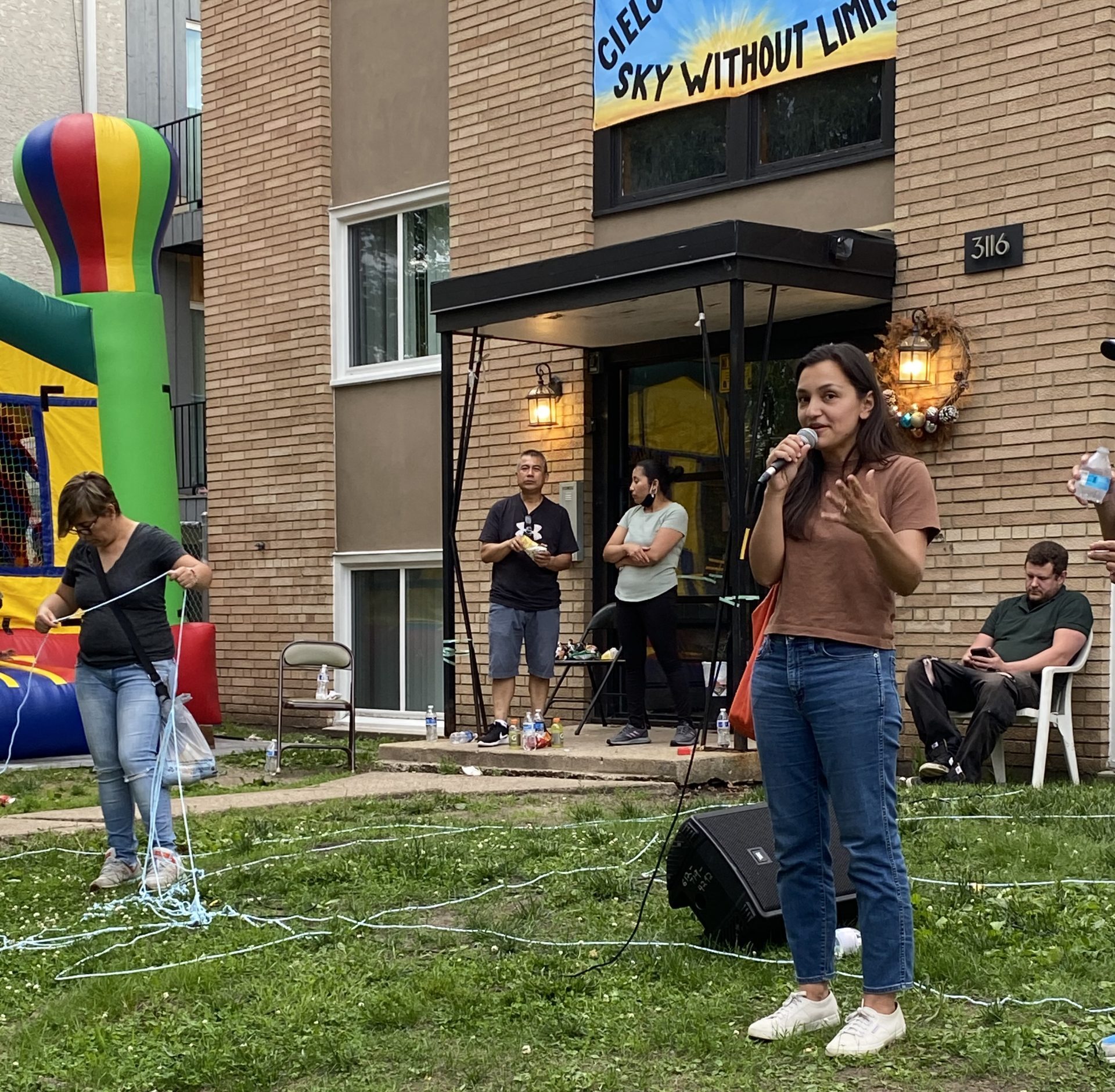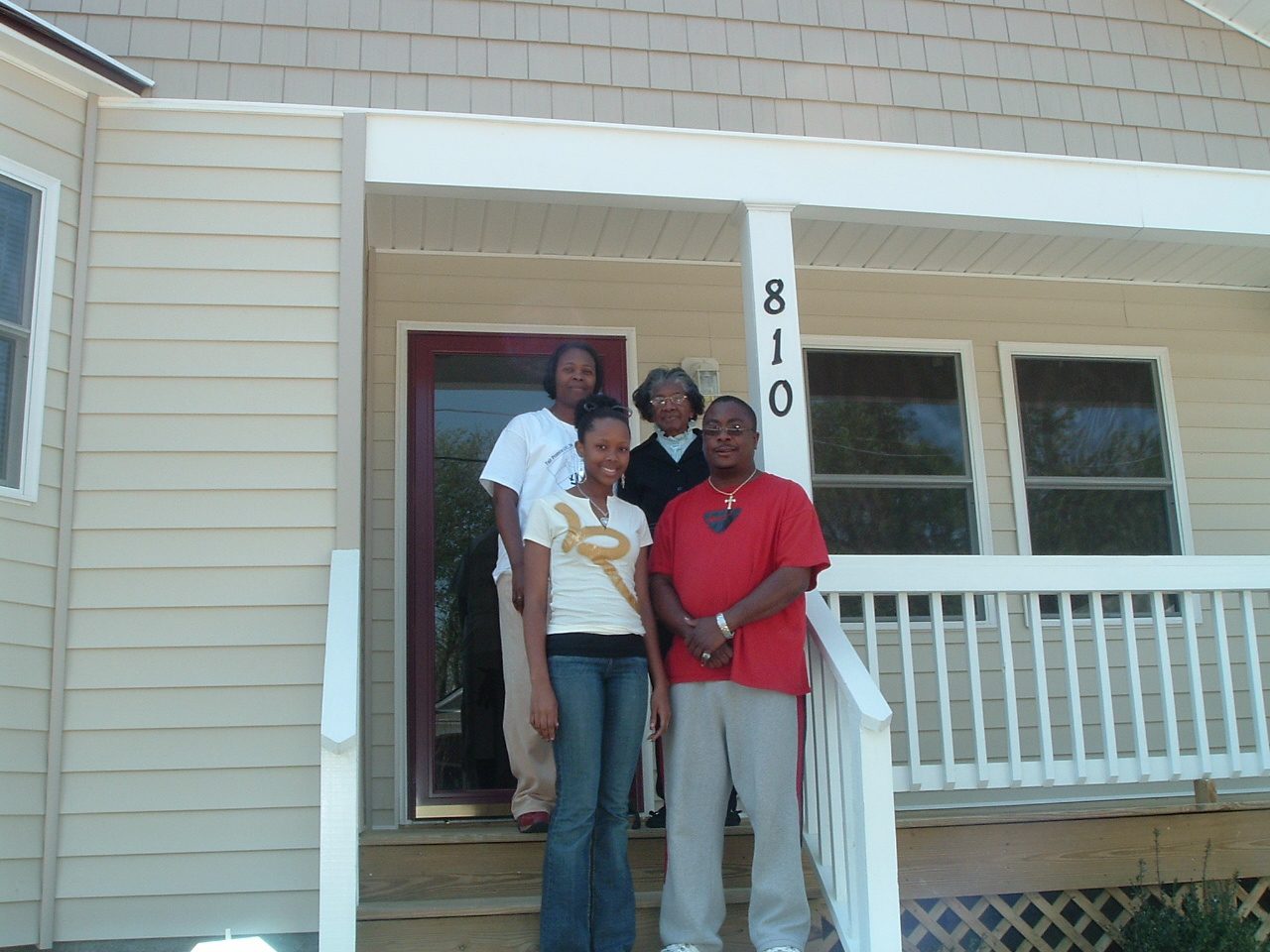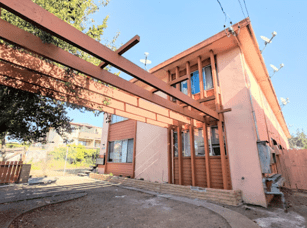This article is part of the Under the Lens series
Community Ownership Takes Center Stage
There’s a growing interest in community control of housing. This webinar was organized and hosted by the Robert Wood Johnson Foundation in April to explore a range of questions around how that is realized—from different community ownership structures, to the process of tenants forming a cooperative, to how larger housing nonprofits can incorporate residents into decision-making. Speakers included Devin Culbertson, the senior program director at Enterprise Community Partners and SPARCC (an initiative of Enterprise Community Partners, the Low Income Investment Fund, and the Natural Resources Defense Council); Roberto de la Riva, co-director of Inquilinxs Unidxs Por Justicia (United Renters for Justice); and Andrea Ponsor, president and CEO of Stewards of Affordable Housing for the Future.
(Editor’s Note: the Robert Wood Johnson Foundation provides financial support for some of our work.)
The following transcript has been edited for length and clarity. Watch the full webinar recording here.
Miriam Axel-Lute: Devin, can you talk about community land trusts, the concept of community ownership in general, and why SPARCC has explored these models?

Devin Culbertson is the senior program director at Enterprise Community Partners and SPARCC.
Devin Culbertson: SPARCC is three national intermediaries in six different regions across the country. We’re working to support community-led approaches to advance racial equity, climate resilience, and improve health. There’s a lot under the SPARCC umbrella, and we’re really looking for things that are intersectional rather than additive. In 2016 [we started] to focus on displacement and investment that drives displacement. And from there, we really landed on thinking about community ownership in a relatively broad way.
We came to that [thinking by listening to] folks interested in increasing agency and community control among tenants and residents, building community power, [preserving] affordable housing [in] high cost [and] gentrifying markets, and then more recently, building wealth and community among community members. There’s a lot of structures there. It’s really critical that whatever structure you choose follows what your goals are. So, for example, a lot of traditional affordable housing has a focus on reducing the rent paid by the tenant. That model and approach does that well. But if you’re looking at some of these other goals, you need to look more deeply at what it is you’re trying to achieve.
We have an incrementally evolving framework that breaks down the different goals that we’ve seen and the approaches to get there. The community land trust structure is a trust that owns the land, and the buyer buys just the house separated typically on a ground lease. We’ve also worked with a handful of models like the Community Investment Trust in Portland, where folks in the community are our shareholders typically in commercial property. So they’re owners in that sense, but they don’t have day-to-day control.
Because we’re thinking about community ownership as ownership by the people and organizations that are in that community, we also look at direct organization ownership, which from the outside might seem somewhat similar to the affordable housing model, but one of the key differences is really focusing on the organization having complete ownership rather than being a general partner with a very small ownership share, and therefore little control long-term once restrictive covenants burn off.
We also think about direct ownership by community members. That could mean things like homeownership initiatives, but for us, it’s [also] things like ADU [accessory dwelling unit] programs that try to sustain low-income owners and help them stay in place and grow their wealth over time while hanging on to the asset that they’ve already acquired.
There’s a lot of interest in community land trusts right now. How have you seen them work and which particular challenges are they best suited for?
Culbertson: Community land trusts have done really well when they are set in a broader network. We have seen a lot of neighborhood-scale CLTs or projects that are disconnected from other elements in their community.
What it takes for a community land trust to get started is organizing work, and then organizational work. You’re making a multi-generational commitment to the homeowners, who are your partners. Being able to sustain that requires a broad network to lift that [work] up and move it forward. That seems to be one of the key elements in making those organizations work.
[A land trust’s] best function is as an anti-displacement tool. They’re particularly effective when they have the luxury of being able [to] start before market forces are already pushing folks out, because the financial hill to climb is so much larger once displacement pressure is that advanced.
The idea of not owning the land on which your house sits has unfortunate connotations for many Black Americans particularly, and yet the first community land trust was created by Black folks in the South as a self-sufficiency and an equity move, and modern CLTs are increasingly serving communities of color. How could CLTs be employed as a racial equity initiative?
Culbertson: This is a real issue. I know a CLT director in the South that diffuses some of the tension around this by joking about selling people half a house. But it’s real, and folks are worried about it. The tools of real estate and finance can be used, and are used, for good and evil all the time. And people of color in this country, particularly Black folks, should have a healthy degree of skepticism for something that seems new or doesn’t quite seem right to them.
That said, there are some elements that are common to CLTs and most community ownership structures that are categorically a step in the right direction. Having a certain percentage of community members on the board as decision-makers in those organizations [is] important. The intentional outreach to folks that are denied access and opportunity for ownership. And building those relationships and socializing this model and this need in the community are critical. That said, making sure that you’re understanding that context as well and making sure that you’re not doing harm is important.
Some folks—Black [folks] in particular—are looking to have access to the opportunities that for generations they hadn’t had. And a lot of those are wealth-building opportunities. So make sure that if you’re thinking about a CLT as a wealth-building structure, there’s a way to truly deliver that.
There are so many new CLTs that [the] commitment to being that long-term partner is really important. I was talking to folks [who] said that homeowners asked them, “Well, what if the CLT goes away?” Which is something that they had not even considered. But as a good partner, you have to [consider that] because you own the land underneath people’s homes. As a practitioner, making sure that you really understand and [have a] business plan for the long game and that you’re able to show up in the ways that you’re making a commitment to [is important].
I’d like to turn to Roberto from United Renters for Justice, which has an incredible story. More than 100 tenants of five different buildings formed a coalition, fought against their landlord, mobilized for better conditions, resisted evictions, and won a major victory. Roberto, can you tell us how you were able to build that coalition and why, as a result, you decided to turn these buildings into a resident-owned cooperative?

Frenz’s mansion [is in] one of the richest areas in Minneapolis. We showed up saying, “We want you to negotiate. We need to stop the violence, mass infestations of cockroaches, no heat in the winter, mass mold.” Many BIPOC communities are essentially feeding the wealth of [his] corporation. He was receiving over 70 percent profit margins. We see time and time again that things get siphoned out of BIPOC communities at the expense of single mothers, children, and our neighborhoods that we’ve been struggling in.
As the four-year process heated up, there were intense protests at the city, there were many, many court actions, there was showing up at the landlord’s office. The single-family homeowners on our block know about us, [they’ve] been in community block parties with us, and [in] our buildings with us. And so we’re changing the way that we relate to each other. The buildings no longer are these places of blight.
We protested Frenz’s church [and] we served him a subpoena while he was praying. The entire cooperative went to this Catholic church—there are many Catholic individuals in our cooperative—[and] we said, “This is a moral issue. Negotiate with us. Sell us the buildings.” We delivered flowers to the parishioners, and we made a big deal out of this. We connected to the archbishop. We’ve had more than 450 people coming together to change the narrative.
Building an organization that is going to help sustain access to that housing going forward is a somewhat different skill set than running and organizing a campaign. Can you tell us how the cooperative acquired the new skills it needs to move into this new phase of ownership, while also protecting your ability to organize?
De la Riva: When you’re organizing against an enemy like a terrible landlord, it’s easy to galvanize. But when you actually have to unlearn the deep-seated processes of property within yourself, it becomes a new story. Something that has been prevalent for us is trying to figure out how we can connect to where we want to go. There’s an interim process right now, where because we galvanized so hard, the city threw down. They said, “We’re not going to let these tenants go high and dry and be evicted, so we’re going to put our own stake and our own money into it.” We have LISC connected to this as well as the Twin Cities Land Bank [and] we’re actually figuring out what our cooperative model is and who we are to have the buildings sold back to us.
We’re changing the idea of rent into an idea of community and connection where we know our neighbors. When there’s conflict, we look at each other heart to heart, and we try to move to a next step to see where we should go. Everybody has in their head this idea of, if you act poorly, you should be evicted. And this is the type of violence that has been trained in our bodies that we need to reframe and reposition.
The court process is such an intense, scary, white-supremacist model. So what do we do? We have pizza parties in court. We bring the kids, we paint on the windows, and we fill the courtrooms to let the judges know that we’re here, we’re present, and we are not going to stop until we [are] heard.
We filled [the court] so much that [there weren’t] enough seats. And the lawyers of the landlord were trembling in their boots, and so they requested security. And I said, “When these lawyers walk through these doors, look them in the eyes. Let them know we’re here.” Can you imagine opening those doors and seeing tenants show up in droves? These are tenants that people are saying aren’t producing community, that they’re transient, that they don’t care about neighborhoods. But we just queered that whole idea.
Andrea, in a recent report with the Center for Community Investment, you wrote about how the U.S. is losing existing affordable housing at an alarming rate. Without preserving what we have, we fall two steps back for every step forward. Can you talk about what SAHF is doing to combat this trend and how you promote community control of land and housing in the preservation work that you do?

Andrea Ponsor is president and CEO of Stewards of Affordable Housing for the Future.
Andrea Ponsor: SAHF, Stewards of Affordable Housing for the Future, is a policy and practice collaborative of 13 nonprofit, multifamily, affordable housing developers who are working together to advance the creation and preservation of healthy, sustainable, and affordable rental homes that foster equity, opportunity, and wellness for all people. We think a lot about preserving affordable homes, and we’re committed to permanent affordability. This is a little different than a lot of the community ownership we’ve been talking about so far. Our role as a collaborative is to think about how you do take those homes out of the speculative market and make them quality, welcoming, and empowering places to live permanently.
That’s what we’re doing on a day-to-day basis. Even at scale, even if you’re a robust nonprofit, just getting hold of those properties can be challenging. So on the policy front, some of what we’re doing is looking around and saying, “What are the practices to promote notice and opportunity [for] potential purchasers before something goes to market and becomes subject to speculation and rising price pressure?” Often that’s an opportunity to say to residents or to community groups, “This is about to happen. Organize, find partners, create that opportunity to partner with organizations like ours or amongst yourself and take control of that housing in one way or another.”
We are working alongside residents to do that in a way that honors the resident vision for the community and ensures that they can remain. There are a lot of people doing this work and taking advantage of subsidies to create affordable homes, but they may not be in it for the long term. And that’s not always just dependent on the tax status of your organization.
So what does community control look like? If it’s owned by a national nonprofit or a regional nonprofit, it can be a few things, and we’re seeing an evolution right now in how our members look at it. First and foremost, it’s allowing people in the community to remain living in the community. But that’s not really enough if you’re doing things to them and operating properties in ways that are informed by generations of racist ideologies about who lives in homes that are affordable.
What are the tools we haven’t been using? How should we be thinking differently about bringing residents into ownership structures and decision-making? We recognize increasingly that it’s imperative that you’re putting decision-making power in the community, regardless of whose name is on the deed.
That happens throughout the process. [It’s] not just [asking], “Do you want a community garden? What trees should [be saved] or [what] neighborhood history we should honor?” But every decision about how you’re operating a property, really fostering the agency in the community, giving them that ability to say, “This is our home, and we should have a voice in how things are being carried out in the property whether we’re renters or not.”
Properties that get the term “naturally occurring affordable housing” tend to get that way through a combination of long-standing public decisions about investment and disinvestment, deferred maintenance, and what we let landlords get away with. But they do house a large percentage of lower-income individuals. And for the smaller-scale ones, many are owned by individual landlords who may not have the resources to weather an economic downturn, and people are worried about those properties getting snapped up by larger corporate landlords. What can be done at the various levels of government to preserve the affordability of these properties and keep them in local ownership?
Ponsor: First is figuring out where these properties are, [and] who owns [them]. And then also creating resources. There’s some great examples out of the District of Columbia. And then there’s notice requirements. No one should be caught off guard that their building is sold. Residents deserve to know, and community institutions and partners that may be able to lend capital and expertise should know as well.
Roberto, how did you fund your years of organizing?
De la Riva: As we became center narrative in the city, we were able to generate a lot of donations. We came up with our own fundraising campaign, and when we came up for the purchase, the landlord and his business partner finally said, “OK, we’ll sell the buildings to you.” It was about a $7 million, but these buildings were sucked dry. There weren’t any repairs [done], and so the total development cost was roughly around $10 million.
The city threw down a $3.4 million loan. LISC came up with a bunch of money, we raised a bunch of money, and the land bank threw down a bunch of money to buy and hold. So right now we’re in the buy-and-hold stage and the refinancing stage. So that’s when we’re reaching out to the Devins of the world, to the Andreas, to really talk and figure out how we’re going to finance this. We’re building that model.
How do you define community when you’re talking about community control? And explain how the people represented by that community are represented in the governance of your organization?
Culbertson: Defining community is certainly slippery and we don’t mistake [it] for being monolithic. It really depends on the project that we’re talking about it, be that real estate or policy work. [We] look for evidence of not just a community, resident, or organization spearheading, but that there is a network to other folks in the community, that there’s more than one voice for a place or neighborhood speaking to that issue.
Ponsor: I would echo Devin’s thoughts around being careful to not think of community as monolithic. How we think of it depends a little bit on the project and the opportunity for engagement. [When] you’re talking about the redevelopment of a site, you’re talking about the larger community—the faith leaders, the civic leaders, and the shop owners. Very often the first stop is the bodega across the street, saying, “Who else should I be talking to?”
When we’re talking about the rules of the road for how you’re going to govern yourself as an apartment community and how you’re going to use your community space, that’s probably the more immediate residents of the building.
We have recently changed our own governance to make room on the board for people who are working in this space [who] have lived experience and bring greater racial and ethnic diversity. Our members have a variety of governance structures at the corporate level that bring in residents or people with lived experience, but then they may also have local and regional opportunities for folks to participate in governance of their communities or of regional entities overseeing development across the state or multistate area.
De la Riva: It’s easy to be a king or a queen and make a decision. But to build alignment with 200 people, it takes work, and it takes time. Deep leaders of the buildings have carried an organizing and cooperative process together, [and] are learning conflict resolution values together. We don’t necessarily know the exact framework of what it’s going to look like, but we know we need to do it together and that we can’t move forward until we step and move together. And so it moves at the speed of trust, and unfortunately, you cannot move that quickly when you’re building trust. You have to be patient.
Thank you.





Comments